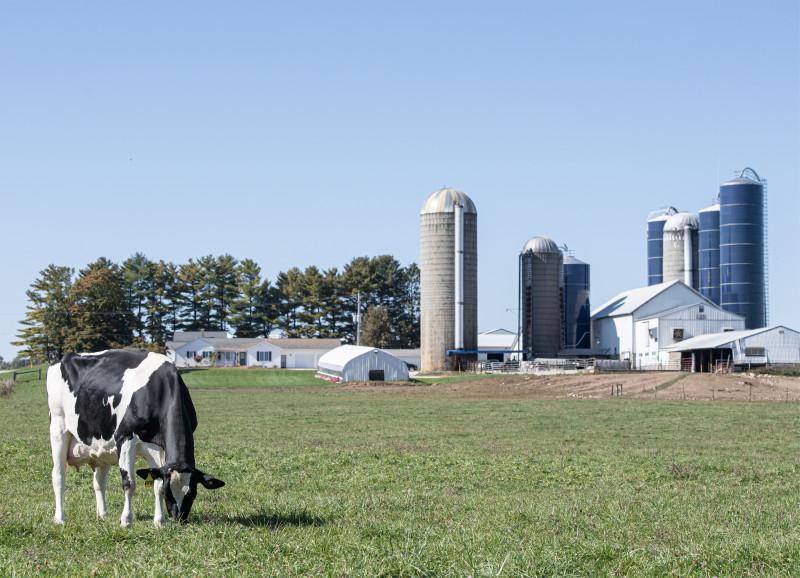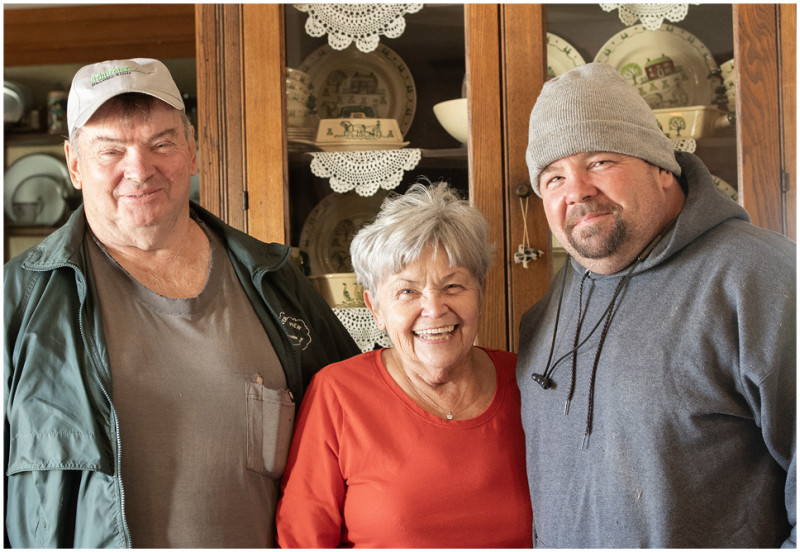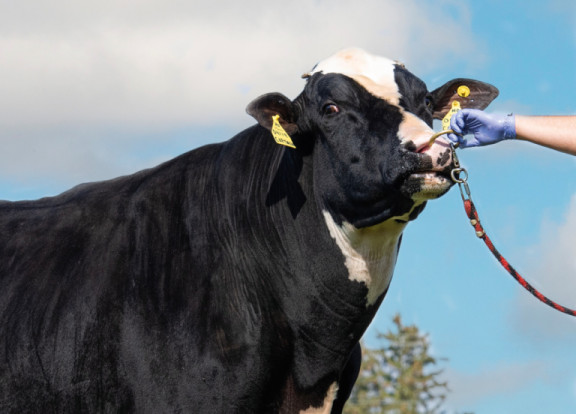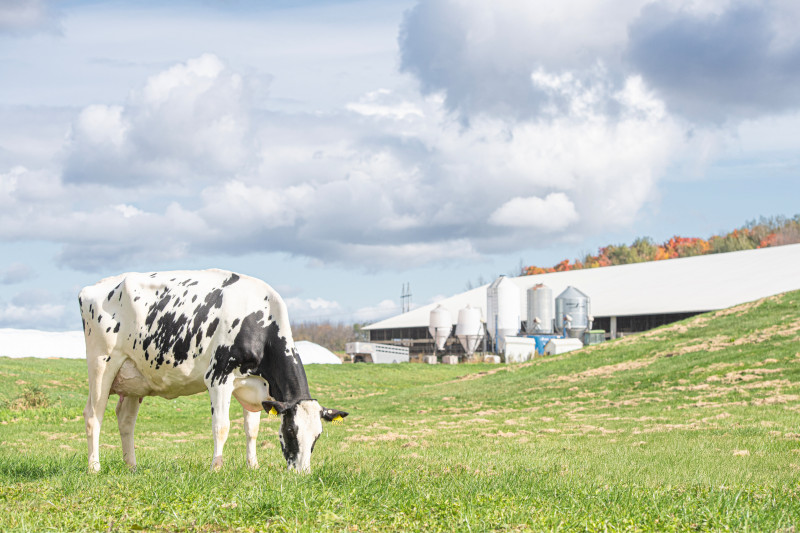
Ever-Green-View Ayla EX-92 (Delta x Supersire) has a top record of 4.09 365 3x 69,530lb/31,533kg 4.7% 3.3% and is one of six outstanding daughters from popular embryo donor Ever-Green-View Ace.
In the 1970s, Tom and Gin Kestell established the Ever-Green-View herd at Waldo in eastern Wisconsin, close to the shores of Lake Michigan. Today they manage the high performing 100-cow herd along with son Chris, his wife Jennifer and their two boys Will (8) and Cole (5). The high impact Ever-Green-View herd has included a number of world champion production cows! And in HI’s overview (2022) the Kestell’s had the highest production herd in the World!
Doug Savage, Han Hopman
This year, Ever-Green-View won the Holstein Association’s Herd of Excellence award for the 13th time! Not only is it the highest producing herd worldwide – with a current average of 42,385lb/19,226kg 4.32% 3.28% - but it also boasts a type BAA of 110.7, comprising 41 scored EX, 53 VG and 13 GP. ‘We don’t try to breed those 94 or 95-point cows, we are aiming at 90 to 92-point cows that are extremely high producing,’ comments Tom Kestell. ‘If you give yourself definite goals and then focus all your efforts on achieving those over enough years, you eventually get there.’ Tom is used to being asked as to how they achieve such high production. ‘Everything on the farm needs to be done right, every day - the crops you grow, the soil fertility, the way forages are conserved, the way you feed the cows, the cow comfort you provide – everyone involved has to have the attitude of doing things just a little better every day. There is really no magical secret; it’s a case of seeing to all the little details, every day. You never compromise.’
QUALITY NOT QUANTITY
Almost all feed is home-grown, which gives them control over the quality from start to finish. ‘It’s important to focus your attention on what you can control. We produce high quality forages. We grow brown mid-rib corn, which has decreased lignin and therefore much higher digestibility, and we chop it at a height of 30-34 inches,’ explains Tom. ‘There is nothing of great value to the cow in the stalk so we leave that behind. The starch in the forage is then up over 40%: We are looking for quality rather than quantity.’ The corn is chopped in somewhat longer length than usual and is processed as shredlage. ‘If you are going to grow good crops then you have to keep up with the soil testing and make sure you have a balanced soil profile to get maximum growth. Then you need to take care of the crop. Insects can do a lot of damage. The right time of cutting, or when necessary, spraying, is important to make sure the insects don’t affect the quality. You can have different silages that look the same but they don’t test out the same. We concentrate on what we can control every day. It’s the whole package.’ While it is now popular to use a grass mixed with alfalfa the Kestell’s prefer to stay with a pure alfalfa stand as they see it as a cheap source of high-quality protein. They feed a one-group TMR ration at 16% protein, and purposefully keep that lower protein level as they find that a low protein and high forage ration is important for good rumen function. Because it is a high forage diet with not a lot of corn in the TMR then acidosis is not a major problem though a buffer of sodium bicarbonate is included.
INTAKE
The ration is comprised of 70% forages and 30% concentrate. It is fed twice a day and is top dressed with home-grown roasted soybeans. ‘The roasted beans help with the palatability and gets the cows to clean up what ever ration is in front of them. That’s important because if cows are sorting through it and leaving some then you don’t have control over their intake.’ Ultimately it’s the dry-matter intake that dictates production and by using the roasted beans as an appetizer along with the high quality forage, intake per cow has climbed noticeably over the years. ‘When it comes to cow comfort, our facilities here are old so we don’t have misters over their stalls for cooling but we do maintain very good air flow through the barn. We do try new things and experiment from time to time, and they don’t always work out the way we expect, but of course that is part of making progress. It’s really the total package - having the right genetics in place, provide the right environment, the right nutrition, and then also your daily work. It’s really just minor details that help to keep that SCS down and that contributes to high production records.’
PRODUCTION CHAMPIONS
In 2010, Ever-Green-View My 1326 EX-92 focused international attention on Ever-Green-View when she broke the world milk record with figures of 4.05 365 3x 72,170lb/32,736kg 3.9% 3.0%. Sired by Morty, she was out of a VG Lantz daughter of the prominent brood cow Ever-Green-View Elsie EX-92 (<Elton). Then in 2016, My’s daughter Ever-Green-View My Gold EX-94 (<Goldwyn) completed a lactation of 4.03 365 3x 77,480lb/35,144kg 2.6% 2.7% to set the world milk record. Now My Gold’s daughter Ever-Green-View My Mint EX-91 (<Montross) is one of the herd’s top producers, becoming the third generation of the family to produce 200lb/91kg per day. Another branch of this family produced the renowned O-Man son from the Netherlands, Flevo Genetics Snowman, who is from a BW Marshall out of an Aaron daughter of Elsie. ‘Supersire and Snowman both produced some tremendous milk cows for us,’ comments Tom. ‘And then Delta and his full brother Dante made some really good solid production cows here too. We tend to use more proven bulls, and we generally look for the better proofs but also the ones with the better pedigrees too. We’ve been using Parfect, Renegade and Pazzle, and now we are using some Lionel. We stayed away from Lionel for a long time as the pedigree doesn’t suggest such extreme production. I don’t expect he’ll leave a lot of EX daughters but we decided its hard to ignore that much milk.’
EXPORTS
For many years Ever-Green-View exported more embryos around the world than any other Wisconsin herd, often sending more than 3,000 embryos per year, and in 2015 was the recipient of the Wisconsin Governor’s Export Achievement Award. ‘We’ve put in a lot of time and effort devoted to developing exports over the years. Russia and China were huge markets for us, but of course the current international climate has really put a damper on those exports. Most recently we’ve had demand from Pakistan, Tunisia and South America,’ explains Tom. ‘The more established countries like Germany and the Netherlands are not big volume markets now.’ There are also live animal exports to Turkey, Mexico and Pakistan, and recently to the Dominican Republic. ‘The group to the Dominican Republic included two heifers and a bull from the record production cow My. The heifers were Kingboys and resulted from embryos that had been in the tank for some time, but they were well grown heifers and should be a great foundation for the Elsie family in that country.’ l

Ever-Green-View in the US

Tom & Gin Kestell and their son Chris.
Located at Waldo, in eastern Wisconsin. Owned by Tom & Gin Kestell and Chris & Jennifer Kestell 800 acres/324ha: Growing crops of corn, wheat, soybeans & alfalfa 120 cows plus 220 heifers Average production: 42,385lb/19,226kg 4.32% 3.28% Type BAA 110.7: 41 EX, 53 VG, 13 GP Feed Ration: 70% forage & 30% concentrate. Almost all home-grown with brown-midrib corn silage, haylage, high moisture corn and roasted soybeans Current Bulls: Parfect, Pazzle, Renegade, Lionel & Sheepster.


